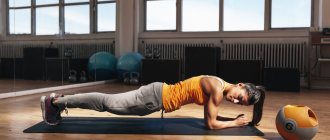Running is one of the most accessible types of physical activity. Minimum equipment, maximum capabilities.
You can go for a run near your house in a park or square, at a stadium, on a treadmill at home or in a fitness club, along the embankment of the resort where you are relaxing.
A variety of training modes: from the easiest jog to intense intervals. This makes running an effective exercise for people with any level of physical fitness.
Clear coordination of movements: everyone who can walk can run (with the exception of health contraindications, of course).
So far, there are more men than women among runners. But the interest of the fair half of humanity in this type of activity is growing every year.
We have prepared this article specifically for women who want to start running. There are a number of nuances, taking into account which you can make running your favorite tool for maintaining good athletic shape for many years. Or even become a reason to be proud of yourself - you can set specific goals for yourself in kilometers and/or minutes and achieve these results.
Let's tell you everything in order!
Motivation. Why run?
It’s worth starting your classes by answering this question. Take 15-20 minutes for yourself and reflect. It is best to write down the answers to the questions on a piece of paper or in your phone notes:
- Why do you want to run?
- What do you want to get from this lesson, what is your goal?
- How much time per week are you willing to devote to training?
- Will you train on your own or with a trainer?
- Where will you run?
Understanding your key motivation and desired conditions of activity will help you build a process so that this activity will bring the desired results, and not undesirable consequences.
Most often they run to:
Lose weight
Cardio exercise triggers the acceleration of metabolic processes in the body. This leads to more active “burning” of calories.
Improve and tone the cardiovascular system
If you notice that climbing stairs causes you to feel short of breath, then this is a signal from your body that your heart, blood vessels and lungs are in a weakened state. A healthy person can climb the 4th-6th floor at a normal pace without shortness of breath. If your performance on this simple test is worse, then there is a reason to start doing cardio exercises.
Relieve psychological stress
Running at a comfortable pace or brisk walking for 20 minutes or more triggers processes in the body that relieve nervous tension.
It may seem that after a busy day at work you no longer have the strength to do anything. But in fact, switching from mental to moderate physical work “reboots” the body. Blood actively moves throughout the body, body muscles become toned, endorphins are produced - “hormones of joy”.
Running is rightfully considered dynamic meditation. Many people note that while jogging, their thoughts become clearer and brilliant solutions come to even difficult life issues.
Be in the company of active healthy people
Nowadays people run for whom it is important to maintain health, a harmonious psychological state and fitness. They understand that moderate exercise makes a significant contribution to their quality of life for many years to come.
Participate in sporting events
The running movement covers all of Russia and the CIS. There are also foreign races - already in almost all countries of the world.
At the races, the organizers provide participants with a prepared route, timing of results, memorable souvenirs, and most importantly, at such competitions you will meet hundreds and thousands of like-minded people who are passionate about running.
This is a real holiday of health and sports, in which the majority of participants are ordinary people, lovers of running.
By the way, if you are an athlete actively involved in sports, if you are an amateur who regularly participates in competitions, then we have special discount cards for you that allow you to receive significant discounts on the equipment, shoes or clothing you need.
Goals for the race can be set as follows:
Participation: the task is to cover the distance without breaking a step (no matter how long it takes).
Result: the task of running a distance in a certain time is already for more prepared people.
How to start running?
To start running, of course, first of all you need to choose sneakers that suit you according to your anatomical features, running technique, and which, of course, you like in design... and go outside. We advise you not to get attached to Monday or any calendar date. Just decide and do it!
All running shoes for women at Kant
Start with active walking. Pay attention to the position of the body: the arms work in opposition to the legs, the neck (and the rest of the body) is relaxed, the abs are toned, the body is slightly tilted forward, the feet land gently on the ground, rolling from the middle part of the foot to the toe.
Move like this for 4-5 minutes so that the body begins to warm up. When you feel warm in your body, you can move on to joint exercises and light muscle stretching. This warm-up is a necessary stage of training if you want to maintain and improve your health, and not harm yourself.
Think over the route so that you can walk actively or lightly to a convenient place or sports ground where you can warm up.
Do joint exercises: roll all the main joints (ankles, knees, hips, shoulders, elbows), do gentle tilts of the head to stretch the neck, and gentle tilts of the body to stretch the back and waist area, the stomach. Next, do 10 squats. You're ready to go for a run. Warm-up should take no more than 5 minutes so that the body does not “cool down”.
Then the main part of the training begins. For beginner runners, this should be 20-25 minutes of light jogging or active walking.
It is most convenient to focus on your pulse to assess the degree of stress your body is experiencing.
To do this, it is convenient to use a special sports watch with a heart rate tracking function.
Choose a sports watch that tracks your heart rate.
The pulse should be no more than 120 beats per minute.
If you don’t have a heart rate monitor, then you can focus on breathing: when the sensation of breathing is in the chest at the level of the solar plexus or slightly higher, the load is optimal. If the feeling of breathing becomes heavy and rises to the throat, the load is high. In this case, you need to slow down your running speed or switch to an active step. There is no need to stop suddenly - a sudden drop in speed puts a lot of stress on the heart.
Here we want to point out the most important thing - run at a pace where you feel comfortable running and don’t have the thoughts “Never again!” Brisk walking is a good alternative to running.
Finish your workout with an active step when your breathing becomes easy again. Be sure to stretch your leg muscles: standing on straight legs, bend forward (pull the back of your legs); lunge to the side (pull the inner surface of your legs); standing on one leg, bend the other leg at the knee (pull the front surface of the bent leg).
A good video on stretching after running can be seen here.
Stretching muscles after exercise is the key to healthy ligaments and joints, which recover and rest only if the muscles that worked during the workout are sufficiently relaxed.
Sprint training
Treadmill workout
Treadmill workout
Quadriceps stretch with squats
- 1 ta
- Body part: Quadriceps Equipment: Body weight
Quadriceps stretch while kneeling
- 1 ta
- Body part: Quadriceps Equipment: Body weight
* — The service is in beta testing
After each 100-meter race, return to the starting line at a slow pace or, if you're running in a stadium, complete a lap. Your rest between races will be this walk back to the start line. If you still feel tired when you reach the line, take another rest or two before starting the race again.
After each workout, it's important to cool down a bit (to prevent cramps), which will reduce the amount of lactic acid in your legs. After completing such a workout, you will feel your body in a new way. Your legs will become more and more elastic, and your abdominal muscles will feel toned.
If you can incorporate sprinting into your weekly training, you will be able to:
- lose weight faster;
- work out the abs;
- increase metabolic rate;
- strengthen your legs and buttocks.
We hope that now you have appreciated all the benefits of running for your figure and will include sprinting in your training program.
Conclusion
To feel real results from running, it is recommended to exercise from 30 tons to an hour three times a week. The most important thing here is regularity. Track your results using apps and gadgets, it's very convenient. Our site has reviews of great options, such as RunKeeper The running app.
If your health allows you, set a running goal, choose the type of running you like and is suitable for you, and start pampering your body today.
Treadmill workout
Treadmill workout
Quadriceps stretch with squats
- 1 ta
- Body part: Quadriceps Equipment: Body weight
Quadriceps stretch while kneeling
- 1 ta
- Body part: Quadriceps Equipment: Body weight
* — The service is in beta testing
If you are faced with a choice between running or walking, you need to pay attention to the following factors:
- If you have diseases of the cardiovascular system, you can only jog or do brisk walking;
- This type of activity is prohibited during pregnancy, diseases of the musculoskeletal system, damage to the spine and joints;
- Race walking is suitable for those who want to learn a new sport;
- The benefits of jogging will be more noticeable, but walking is easier. Therefore, with regular training, it can produce a better effect.
Running or walking: what to choose? These things do not replace each other, so it is best to alternate them - jogging 2-3 times a week, and walking the rest of the days. Then the benefits of running for the body will be noticeable.
Three Keys to Keeping Your Desire to Run
A) Regularity
The optimal amount of training for a beginner: 3-4 times a week - maximum. For example, running on Monday, Wednesday, Friday and/or Saturday. On other days, rest or light exercises to strengthen the abs (torso crunches and/or planks) and legs (squats, lunges). This will enable the body to recover well physically and emotionally and adjust to a uniform rhythm of work and rest.
If your life schedule is fluid, then train according to the following principles: the break between workouts should be at least a day and no more than three; It’s better to run twice every week than to run four times in one week and then do nothing at all for two weeks.
B) Gradual increase in load
Many people started running and quit after two weeks. Most of them neglected the golden rule of all training: you need to start with a small load, which your body will perceive as joy, and not as stress and punishment.
Intense walking is a good alternative to slow running if it is still difficult for you. Or if you are overweight (more than 10 extra kilos).
Remember that it is not the cool runner who immediately ran fast and a lot, and then did not go out for a second run due to muscle pain, shortness of breath and the shock of the nervous system from such a “sport”. Cool is the one who started small. If the last time you ran was at school/college, or if more than a month has passed since your last run, then start with walking training.
Walk one stop to transport or leave the car a little further from the office and take a walk.
For the first week or two, just walk at a normal pace. It is better to take two 10-minute walks a day than to run a kilometer in 6 minutes in one run.
Then move to a faster pace. With each workout, you can increase the distance covered by 100-200 meters. You will notice that these workouts are easy. There is no resistance to going outside just to take a walk.
If you are ready to jog a little, then start alternating between walking and slow running:
Run slowly for 1 minute (pulse up to 120-140 beats per minute).
Then walk actively for 3 minutes, helping yourself with your hands (pulse should drop to 100-110 beats).
Repeat this so many times to feel warmth in your body, but not experience severe discomfort.
This regime gives the heart, blood vessels and lungs a moderate load, protects the joints, and does not overload the nerves - training occurs at an acceptable level of load.
The gradual increase in load is extremely important for the health of the immune system: the body needs to adapt to a new rhythm of work, because when we move at a higher speed than usual, all systems of the body need to readjust to a new regime. This is beneficial for the body only if the load increases smoothly and gradually. It is also necessary to do training regularly, as we wrote above. After long breaks, you will need to start from the beginning - with walking.
Then you can gradually increase the duration of the running segments and reduce the duration of walking. If you practice regularly, you will feel progress: breathing will become easier, the body will adapt to the alternating speed of movement. You will want to increase your overall training duration. You can increase the total number of minutes by 10% each week.
If the word running gives you a feeling of heaviness, pain and suffering, then you are running too fast. Slow down or walk briskly at a speed that makes the workout enjoyable.
With this approach, the issue of motivation to train will be automatically resolved. We all love to do what makes us happy.
B) Conscious plan
Think ahead and imagine:
- What days of the week will you train? What can affect the transfer of training? It’s best to put workouts on your calendar - this way there’s less risk of missing them due to other important things.
- Where will you train? Outdoors or indoors? What kind of surface will you be running on?
- The answers to these questions will determine what equipment you will need to prepare for your workout.
For example, running on asphalt will require sneakers with more pronounced cushioning than running on a dirt track or treadmill belt.
"Women's" sneakers for running on asphalt
"Women's" sneakers for running on dirt
"Women's" treadmill running shoes
For indoor activities (where it can be hot and stuffy), you need a light running uniform:
- Top/sports bra
- T-shirt
- Lightweight shorts/breeches.
Running outside, especially in windy, rainy and cool weather, usually requires adding:
- jackets
- warmer trousers
- or tights
- or even thermal underwear.
If you run outside of where you live, you will most likely need a convenient bag to store and transport your uniform and sneakers.
Is running in the morning beneficial: tips for beginners
If you are new to this activity, you should start exercising gradually, otherwise it can lead to sprains, muscle pain, calluses on the feet and increased fatigue. After such a set, you won’t want to repeat your morning “feat” the next day.
Enter the sport gradually, start with a short workout, alternate jogging with walking, but don’t stop. Our recommendations:
- Before you start, evaluate your preparation - whether you have trained before, what is the interval between these periods.
- Are you overweight? Usually, overweight people have a more difficult time taking their first steps.
- Buy sneakers with good cushioning and sportswear made of breathable fabric with ventilation. Don't skimp on ammunition. If you are starting in winter, we recommend ordering equipment from the Stayer online store. In the catalog you will find a large selection of insulated jackets and trousers, which are characterized by wear resistance and the necessary air circulation.
- Spend the first 10 minutes warming up. Without warming up the muscles, there is a high probability of damaging the joints.
- Remember that running is also an exercise, which means it has its own execution technique that you need to follow.
- Take your heart rate before and after your run, or invest in a heart rate monitor.
We will also give some recommendations that will help you get the job done and not give it up halfway.
Tip 1: overcome laziness
The habit is developed within three weeks. Exercise daily, force yourself to get out of bed early, so that after 21 days it becomes a pleasant and easy ritual. Come up with a reward for keeping your word to yourself.
Tip 2: Find a company
Is it worth running in the morning if the bed is much warmer and more comfortable? But the question changes dramatically if a friend, colleague, neighbor or other half is already waiting for you on the street. You won't want to let your companion down or show yourself in an unfavorable way and be forced to go.
Tip 3: Make a bet
It’s always unpleasant to lose, and if you, for example, gamble money, it’s also costly. It is advisable to argue with someone who will control you. It could be a family member or neighbor who is always looking out the window. This will be an additional incentive for new achievements on the treadmill.
What muscles are involved in running?
The main muscles that need to work when running are the thighs (especially the inner surface) and the abs. What is the essence of their work: for the listed muscle groups, the main task when running (as well as when walking) is to maintain body balance. After all, when we run, we are constantly balancing from one foot to the other.
It is the abs and inner thigh that are closest to the center of gravity of the body; they are the easiest to keep the body in balance.
Please note that if your shoulders and calves are very tense when running, it means your abs and inner thighs are not engaged enough in the work. And this is a reason to strengthen them so that the muscles have enough strength to keep your body balanced while running.
Weekly program
You will get the best results from jogging only if they are regular and follow a properly selected program. The program is necessary to systematize and balance the load on different muscles. Naturally, while playing sports, it is recommended to give up bad habits, review your diet, throwing out all the food “garbage”.
Before each run, it is necessary to warm up and stretch. This is very important to prevent any injuries or cramps while running. Concentrate on your legs, calves and thighs, as these are the muscles that are worked first when running. However, pay attention to other parts of the body as well. Stretch your neck, core and hips to ensure good blood circulation, this will increase muscle flexibility and make running a more enjoyable experience.
Why do my knees hurt?
This is the most popular question among those who start running. Let's highlight a few points here.
A) Firstly, slight discomfort in the knees (as in other joints of the body) is a natural phenomenon. In normal life, joints and ligaments work less intensely than when running. When the speed of our movement increases and shock load is added, it is natural that the body organs need to adapt to the new level of load. The same two basic principles work here: regularity of classes and a gradual increase in load. If you start with small runs at an easy pace, then the joints, like all other organs and systems of the body, will be able to gradually adapt. The function trains the organ. If you move, the organs involved in the movement become stronger.
The main thing: the unpleasant sensation should not cause you much discomfort and in no case should it progress.
B) Secondly, we will tell you in general about the main causes of knee pain. Often in the course of life, people have overstrained the muscles of the anterior thigh (quadriceps). This causes the ligaments that attach the quadriceps to the knee joint to be in tension: they are tightly connected to the tense muscle and cannot relax until the muscle relaxes. And if the tension is not relieved for a long time, it causes inflammation of the ligament and, accordingly, pain.
We mentioned above that excessive strain on the calf muscles is undesirable. It can also negatively affect the sensations in the knee, because... The calf muscles are also attached by ligaments to the knee joint.
What to do? It is necessary to warm up the muscles before training so that not “cold” but warmed muscles begin to work. It is also extremely important to relax the muscles after exercise: do good stretching and give the muscles enough rest so that they have time to recover. Massages (from a specialist or self-massage) and hot baths help a lot.
It is also important to strengthen the muscles of the buttocks: good tone in this area “unloads” the quadriceps, taking part of the load on itself. It's functional and beautiful :) Pay attention to the relaxation of your feet. Special rollers and balls are affordable gadgets that will make your feet feel great.
Videos in which a sports doctor talks about the causes of knee pain and ways to relieve pain can be seen here, as well as in this video:
We encourage you to be attentive to your health. If you have questions about the presence of contraindications, it is best to ask them to sports doctors who work in medical institutions focused on working with athletes. These specialists work to ensure that people recover well from injuries and continue to play sports for as long as possible, with the greatest health benefits. They will give recommendations (and, if necessary, treatment) for a speedy recovery, and will not advise you to “lie down on the couch.”
Benefit for health
Dizziness and the urge to vomit cannot be called normal phenomena.
If they accompany your workouts, something has gone wrong. However, almost all athletes have had to deal with this problem. There may be several reasons, as well as solutions. The first possible mistake is eating a heavy meal before starting exercise. Either you ate too much or food that is difficult to digest and then waited less than an hour before running. As a result, the body must solve two difficulties at the same time - spend energy on muscles and absorb food.
The second possible mistake is exactly parallel to the first - insufficient nutrition, namely, there are few carbohydrates in the blood. If you are on a strict low-carb diet, then running is contraindicated for you. The benefits of jogging can only be if all microelements and the full composition of BJU are present in the body. It is considered beneficial to drink sweet tea an hour and a half before class.
It could also be a health problem, such as low blood pressure. It may decrease or be low initially. Then nausea will be accompanied by dizziness and darkening of the eyes with sudden changes in body position. If you are a weather-sensitive person, choose the right weather for cardio training, and in case of pathology, you should take medications prescribed by your doctor or special food - coffee in the morning not only invigorates, but also increases blood pressure. In any case, it is worth consulting with a specialist.
If you exercise in a hot room or outside in the sun, your body temperature increases by a maximum of 1 degree. This, as well as the internal heat generated by the muscles, leads to active sweating as an effective way to cool the body. Significant losses of fluid from the body can lead to severe dehydration, which causes nausea and dizziness. Similar symptoms appear with heat stroke. To avoid overheating, we recommend:
- choose gyms with a good air conditioning system;
- in summer, run in shady places, wear a hat;
- take a small bottle of cool water with you, take small sips from time to time;
- in winter, exercise only in high-quality sports suits made of breathable fabric and with good ventilation, such as those made by the Russian brand Stayer.
If you have chronic diseases or exacerbations of diseases, you need to consult a doctor. Only he, taking into account all the nuances of your condition, will say whether running is beneficial or harmful for you at the moment.
Balance your diet, jogging and sleep schedule, take water with you and dress properly, then you will not feel nausea and dizziness.
Choose a clean place with fresh air, preferably in the morning, before 8 o’clock. We recommend you:
- Buy a heart rate monitor and monitor your heart rate.
- In the gym, take a program with a trainer for the correct technique.
- Gradually increase the load.
- Visit your doctor before starting sports.
- Eat right.
- Quit bad habits; smoking and jogging are not compatible.
- Choose comfortable sports shoes and clothes, do not skimp on equipment.
Let's look at how running is good for your health. The benefits of jogging for the body are as follows:
- Increased heart rate while jogging. This process leads to improved blood pulsation, which increases the metabolic rate and cleanses the body;
- Decreased heart rate. If people run regularly, their heart rate decreases - this suggests that running is good for the heart;
- Reducing the risk of hypertension and hypotension;
- Positive effect on the functioning of the digestive system;
- Normalization of hormonal levels. The volume of adipose tissue decreases, which is beneficial for running for your figure. The appearance of the skin also improves;
- Reducing the likelihood of stroke, heart attack, lung cancer and diabetes;
- Strengthening the immune system;
- Increased endurance;
- Improving blood circulation in the pelvis. This has a positive effect on the duration of intimate life;
- Acceleration of cell growth, influence on rapid wound healing;
- Increasing the rate of blood circulation, which slows down the aging process of the body;
- Relief from stress. Many diseases appear due to depression and stress. Running calms you down and produces the “happiness hormone” – endorphin.
How is women's running different from men's?
Perhaps there are only two obvious differences between women's and men's running.
Women have less muscle mass and lower levels of testosterone in the blood than men. This means that women's running speed will be lower.
If you are training in a group where there are men, and you are a gambler, then do not be discouraged if you cannot catch up with your partners in speed. At the same time, women, as a rule, are more resilient than men and, on average, can run leisurely longer distances.
The second difference is this: the fair half of humanity is called the “weaker sex” due to the structural features of the pelvic muscles of the female body. We recommend that women pay attention to strengthening these muscles. This will help avoid discomfort during running loads and at the same time improve the condition of the internal organs.
Useful exercises can be seen in this video:
As you understand, anatomical features are not a reason not to engage in your favorite activity. Approach the issue comprehensively and thoughtfully - this is the key to health and improved body condition.
Running to lose weight
Running is the best way to burn calories naturally, quickly and without harm to the body. No form of fitness will bring the same results or improve your health as running. The program below is quite general. Therefore, if you find it difficult to run while jogging, then slow down or switch to walking. But try to stay in motion for the specified amount of time. If you want to lose excess weight, review your diet and run (+ exercises) according to the following program:
Equipment
Honestly, it doesn't matter what gear you have to start running. Just put on some athletic shoes and loose clothing and get started.
Between “run in sportswear that you already have” or “wait until a complete set is purchased,” choose the first. Once you start exercising, you will better understand the characteristics of your body and quickly select the equipment that suits you.
https://www.kant.ru/catalog/product/2784251/ https://www.kant.ru/catalog/product/3007547/ https://www.kant.ru/catalog/product/1791385/
After some time spent running, reading special articles, talking with more experienced runners or professional salespeople in sports stores, you will gradually figure out what exactly suits you best?
A competent consultant will ask you about the intensity of your training, the type of surface on which you run, measure the pronation of your feet, and also offer several models to choose from. By trying them on and remembering how your feet feel when you run, you can choose the best pair for you.
After two or three runs in the sneakers that you have, but which were most likely bought unconsciously, you will understand how you feel. The main difference between the right running shoes is good shock absorption and a reinforced heel support area.
Women's sneakers with increased cushioning
Check out our special article “The Best Asphalt Shoes for the Start of the Season.” How to make the right choice? there, it talks about sneakers with additional cushioning.
Women's sneakers differ from men's in several ways:
- The colors used are brighter and, as a rule, there are several design options for one model.
- The weight of the sneaker is less: since women weigh less on average than men, less shock-absorbing material is needed. Due to this, the sneaker itself is lighter.
- Narrower last: Women's feet are narrower. In this case, the front part of the last is wider than the heel part.
- In the heel area, the distance from the insole to the top of the sneaker is smaller: for women, the distance from the sole to the ankle is less than for men.
- The size range is limited to sizes 41-42.
You can read more about running shoes in our articles:
- “Saucony 2021 Sneaker Collection Review”
- “Review of the Brooks 2021 sneaker collection. From asphalt to trail”
- Battle of the “carbons”: Saucony Endorphin Pro vs Brooks Hyperion Elite 2. Comparison of two American speed monsters
- Choosing the right supportive running shoes. Using the example of Saucony Guide 14 and Hurricane 23
- Selection of versatile sneakers. Using the example of Saucony Ride 14
- ASICS Spring/Summer 2021 Running Shoe Collection Review
- The right choice of sneakers for the off-season. Trail and trail running models with Gore-Tex
- Hoka One One - new items and legends of the 2021 season
- Sneakers with carbon fiber. Review of carbon rockets from Asics, Hoka, Saucony, Adidas and Brooks
- Review of the Saucony Endorphin collection. The same you, but faster!
- The best asphalt sneakers for the start of the season. How to make the right choice?
- Suunto sports watches. Important features and necessary functions
Full set of equipment
Manufacturers of sports equipment offer a wide range of clothing and accessories that are developed using high technology. Sports equipment is created and improved for the most effective and comfortable training.
Moisture-wicking and windproof fabrics - for maximum comfortable body thermoregulation. Reflective fabrics - for safety in the dark.
Eco-technologies – to take care of the environment.
Also, special equipment is created according to patterns that take into account the anatomy of the female body and the biomechanics of movements. In such equipment you will have a feeling of smoothness and consistency of movements. Bright colors create a cheerful mood and add motivation to go for a run.
General principles for selecting equipment:
According to weather
You should dress in a way that makes you feel comfortable. In cold weather: moisture wicking away from the body and wind protection, if necessary, an additional layer of insulation. Be sure to protect your forehead and ears, hands and ankles (joints do not like cold).
In warm weather: moisture wicking. Remember that if you are hot in your clothes, this will be an additional reason for your heart rate to increase. When it rains, it is very convenient to wear a cap or visor - raindrops will not interfere with your eyes and you will not squint.
To size
It is optimal to choose clothes that fit slightly loosely on your body. This guarantees comfortable movement. The only exception is underwear - it must fit tightly enough. Choose a top that suits your figure.
Taste
Your reflection in the mirror should please you - it inspires you :)
Alone or in company? With or without a coach?
Whether to run alone or in a group – each runner chooses for herself. Let's list the main pros and cons of each choice.
Run on your own
This is convenient when time for training is limited. In this case, you only need to adapt to your schedule.
Running in company
You can combine jogging with chatting with friends. At an easy pace that allows you to maintain a conversation, you can discuss all pressing issues. This, by the way, is a good indicator: if you can speak while running, it means your fitness is growing.
But in a group you will need to agree on the time and place of the run, so you are dependent on your partner. Although this also disciplines at the same time: it is more difficult to skip when a friend is waiting at the appointed hour.
Running without a coach
If you started training according to the recommendations from our article, then after about a month of regular training you will want to diversify the load. A lot of options can help here: standard programs in free applications on your phone or information about the principles of a training plan that can be found on the Internet. You can run “according to your mood”: as much as you want right now. However, as you understand, this approach cannot guarantee clear results and safety for health.
Running with a trainer
This option is for those who value efficiency. If you have a goal, then a trained specialist will be able to guide you to it in the shortest possible way. A coach is a person who has already gone from starting classes to achieving certain results; he has experienced difficulties and will tell you how to avoid them.
You can study by receiving a plan online, or you can study in person: in a group or individually.
By the way, if you work out with a coach, then you will probably want to go to training camps. About what it is, how to take part in them, see our special article “Training Camps. Where and why to go?”
If you decide to work with a trainer, we recommend training companies that are our partners, the quality of whose work we are confident in, that have the necessary level of expertise and have been working in the fitness market for a long time:
- World Class
- ProTrainer
- I Love Supersports
- S10.run
What time to start jogging
Morning is a different concept for everyone, it all depends on how you get up. Let's mark this period like this - after you wake up, but before lunch. Four time periods can be distinguished:
- From 4 to 5. Suitable for absolute early risers. The advantage is the complete absence of people, cars, as well as the awakening of nature, the first glimpses of dawn, the smell of dew.
- 6 – 7. The interval is most popular because there is time to get ready for work and have a measured breakfast.
- 8 – 9. These are the hours when there are a lot of passers-by and transport on the streets. If you run in crowded places, you will disturb others. It’s better to take a closer look at forests, stadiums, and parks.
- 10 – 11. Suitable if you work on an individual schedule, but in the summer by this time the sun can be very hot. Don't forget to wear a hat.
You must get up at least an hour before class.
Nutrition
- Once you start exercising, your appetite will likely increase. This usually causes bewilderment: how can you lose weight and be slim if you constantly want to eat? We recommend adding more “complex carbohydrates” to your diet. These are whole grain products and cereals. They do not cause a spike in blood sugar levels, and therefore the feeling of fullness from such foods lasts longer.
But it is better to minimize refined sugar and flour or completely remove it from the diet.
- Pay attention to how your body feels during a run from this or that food: dairy products and fruits, some vegetables can cause discomfort. If you notice such patterns, then on the day of training, eliminate foods that lead to discomfort.
- Drink enough clean water. Water is just water, not tea/coffee/drinks. You can stick to the usual 2 liters of water per day, and if you sweat profusely during training, you can add one or two more glasses.
- A good solution for health would be to monitor the level of microelements in the blood: iron, potassium, magnesium, zinc. It is convenient to check these indicators during your annual preventive examination, just like the condition of your heart.
Safety
When you have determined the goal of running, eliminated health contraindications, selected the ideal equipment, and even acquired the best training plan for you, then it seems that nothing else can interfere with jogging.
However, when talking about women's running, it is important to mention safety. These days there are more and more people running on the streets and in parks, but despite this, a running person can still cause a rather violent reaction from passers-by.
Women may face intrusive glances, comments directed at them, and perhaps even attempts at physical advances. This can be quite unpleasant. Try to ignore the comments and abstract yourself. Staying calm, keeping a calm face and moving on is the best course of action.
Choose the time and place for jogging depending on the area and city where you run. Agree with loved ones or friends to run with you if you feel some uncertainty about safety. Take your dog (if he is large enough) with you for a run.
In any case, remember that you can always actively call passers-by for help, run into the nearest cafe or store. Well, choose less bright equipment if you have concerns.











